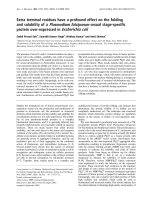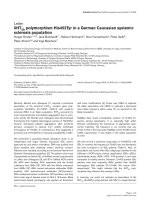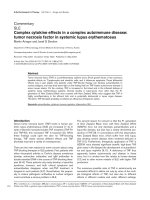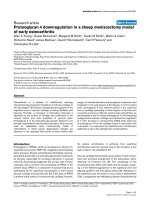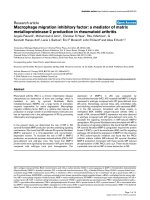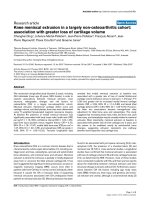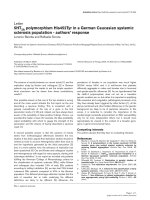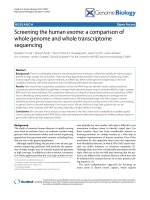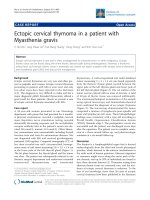Báo cáo y học: "Prolonged mechanical ventilation in a respiratorycare setting: a comparison of outcome between tracheostomized and translaryngeal intubated patients" potx
Bạn đang xem bản rút gọn của tài liệu. Xem và tải ngay bản đầy đủ của tài liệu tại đây (197.61 KB, 7 trang )
RESEARC H Open Access
Prolonged mechanical ventilation in a respiratory-
care setting: a comparison of outcome between
tracheostomized and translaryngeal intubated
patients
Yao-Kuang Wu
1,2†
, Ying-Huang Tsai
3,4*†
, Chou-Chin Lan
1
, Chun-Yao Huang
1
, Chih-Hsin Lee
1
, Kuo-Chin Kao
3
,
Jui-Ying Fu
3
Abstract
Introduction: Mechanical ventilation of patients may be accomplished by either translaryngeal intubation or
tracheostomy. Although numerous intensive care unit (ICU) studies have compared various outcomes between the
two techniques, no definitive consensus indicates that tracheostomy is superior. Comparable studies have not been
performed in a respiratory care center (RCC) setting.
Methods: This was a retrospective observational study of 985 tracheostomy and 227 translaryngeal intubated
patients who received treatment in a 24-bed RCC between November 1999 and December 2005. Treatment and
mortality outcomes were compared between tracheostomized and trans laryngeal intubate d patients, and the
factors associated with positive outcomes in all patients were determined.
Results: Duration of RCC (22 vs. 14 days) and total hospital stay (82 vs. 64 days) and total mechanical ventilation
days (53 vs. 41 days) were significantly longer in tracheostomized patients (all P < 0.05). The rate of in-hospital
mortality was significantly higher in the translaryngeal group (45% vs. 31%;P < 0.05). No significant differences were
found in weaning success between the groups (both were >55%) or in RCC mortality. Because of significant
baseline between-group heterogeneity, case-match analysi s was performed. This analysis confirmed the whole
cohort findings, except for the fact that a trend for in-hospital mortality was noted to be higher in the
translaryngeal group (P = 0.08). Stepwise logistic regression revealed that patients with a lower median severity of
disease (APACHE II score <18 ) who were properly nourished (albumin >2.5 g/dl) or had normal metabolism (BUN
<40 mg/dl) were more likely to be successfully weaned and survive (all P < 0.05). Patients who were
tracheostomized were also significantly more likely to survive (P < 0.05)
Conclusions: These findings suggest that the type of mechanical ventilation does not appear to be an important
determinant of weaning success in an RCC setting. Focused care administered by experienced providers may be
more important for facilitating weaning success than the ventilation method used. However, our findings do
suggest that tracheostomy may increase the likelihood of patient survival.
Introduction
Increasingly frequently, patients maintained on pro-
longed mechanical ventilation (PMV) are given a tra-
cheostomy [1]. Tracheostomy is thought to offer several
advantages over traditional translaryngeal intubation,
including improved physical and psychological comfort,
decreased risk of inadvertent extubation, accelerated
weaning from mecha nical v entilation, decreased time of
ICU stay before transfer to step-down facilities, and a
reduced risk of developing ventilator-associated pneu-
monia [2,3]. Despite the increasing use of tracheostomy
for PMV, currently no consensus exists as to whether
* Correspondence:
† Contributed equally
3
Division of Pulmonary and Critical Care Medicine, Chang Gung Memorial
Hospital, No. 5 Fu-Shin Street, Gueishan, Taoyuan, 333, Taiwan
Wu et al. Critical Care 2010, 14:R26
/>© 2010 Wu et al.; licensee BioMed Central Ltd. This is an open access art icle distributed under the terms of the Creative Commons
Attribution License (http://http//creativecommons.org/ licenses/by/2.0), which permits unrestricted use, distribution, and repr oduction
in any medium, provided the original work is properly cited.
this technique is associated with definite outcome bene-
fits, as compared with translaryngeal intubation [ 4]. No
study to date has compared the outcome o f tracheost-
omy and translaryngeally intubated PMV pat ients in a
specialized Respiratory Care Center (RCC) setting. All
previous studies have been conducted in ICU settings.
The aim of the present study was to test the hypothesis
that tracheostomy improves the outcome in patients main-
tained on PMV in an RCC setting. The major outcomes of
interest were weaning success and mortality rate.
Materials and methods
Setting
Chang Gung Memorial Hospital is a 3,800-bed t ertiary
medical center containing 350 ICU beds. The 24-bed
RCC unit was established in November 1999 as a part
of a policy transferring responsibility for general ICU
patients experiencing MV weaning difficulty.
Patients and RCC admission criteria
All patie nts transferred to the RCC between November
1999 and December 2005 were identified. Patients were
included in this study if they had been maintained on
MV in excess o f 3 weeks before RCC admission, and all
previous weaning attempts had failed.
Patients were eligible for RCC admission if they met
the National Health Insurance (Bureau of National
Health Insurance, Taiwan) requirements: hemodynamic
stability, no vasoactive drug infusion for 24 hours or
more before transfer, stable oxygen requirements (frac-
tion of inspired oxygen 40% or more, and positive end-
expiratory pressure less than10 cm H
2
O), no acute
hepatic or renal failure, no requirement for surgical
intervention within the ensuing 2 weeks, or if the
attending pulmonary physician deemed it beneficial for
the pa tient to be transferred to the RCC. No other prin-
cipal restrictions were placed on admission to the RCC.
Admission decisions were not based strictly on diagno-
sis, route of MV, prognosis, weaning, or rehabilitation
potential. Any p atient who became hemodynamically
unstable or had multiple organ failure was transferred
back to the appropriate ICU. Most (97%) of the RCC-
study patients were admitted from the institutional ICU.
The remaining patients were transferred from other
hospital ICUs.
Terminal cancer patients and those patients who had
been given tracheostomies before RCC admission were
excluded from this study. The reasons for excluding
terminal cancer patients were short life expectancy and
the fact that (in our experience) families of these
patients tend to deny any request for tracheostomy.
Although some patients were admitted to the RCC on
more than one occasion during a single care episode,
for statistical purposes, data were recorded for the first
admission only.
Indications for tracheostomy included the following:
necessity for PMV, failed extubation or reintubation,
unrelieved upper-airway obstruction, airway protection
(includingtheneedofairwayaccesstoremovesecre-
tions), and avoida nce of compl ications associated with
translaryngeal intubation. All tracheostomies were per-
formed by a surgeon or ear, nose, and throat specialist
in a surgical operating room. Indications for continu ed
translaryngeal intubation included a short predicated
lifespan (less than 2 months) and refusal of tracheost-
omy by the patient or relative(s).
This study was approved by the Institutional Internal
Review Board. Informed consent was obtained from
either the patient or the patient’s family at discharge.
RCC description
Nurse-to-patient r atios in the RCC were 1:3, and
respiratory therapist-to-patient ratios were 1:8. Specia-
lists in pulmonary and critical care medicine served as
primary physicians for all patients. In-hospital night
coverage was provided b y fellow trainees. Consultation
services were available for most medical and surgical
specialties.
The weaning process involved daily targets of either
increasing periods of spontaneous breathing or a gradual
reduction in pressure support. Other aspects of RCC
care included identification of reversible causes of wean-
ing failure, limited use of sedatives, restoration of nor-
mal sleep/wake cycles, attention to nutrition, pulmonary
rehabilitation (including re spiratory muscle training),
and attempts to improve patient autonomy through
methods such as establishing speech and self-feeding.
Discharge planning was managed by nurse or social-
work case managers. Hemodialysis was available in the
RCC as required.
Variables measured
The following variables were recorded for all study
patients within 24 hours of admission: demographics,
previous ICU type (medical or surgical; MICU or SICU),
cause leading to PMV, duration of ICU and RCC stay,
days on MV before RCC admission, total days on MV,
day of tracheostomy after RCC admission (if the proce-
dure was performed), Acute Physiology and Chronic
Health Evaluation II (APACHE II) score, serum albu-
min, blood urea nitrogen (BUN) level, and blood gas
data. “To tal mechanical ventilation days” was defined as
the time from initiation of M V to the time when wean-
ing was successful or attempts were ceased. “Length of
(hospital) stay” was defined as the time from ICU
admission to the end of hospital care. The highest
Wu et al. Critical Care 2010, 14:R26
/>Page 2 of 7
modified Glasgow Coma Scale scores (GCS: verba l score
as one) were also obtained by nurses within the first 24
hours of admission. Rapid shallow breath indices
(RSBIs), arterial oxygen pressure/fraction of inspiratory
oxygen (PaO
2
/FIO
2
), and maximal inspiratory negative
pressure (PI
max
) were also measured during spontaneous
breathing. PI
max
values were determined as the mean of
three measurements by using a Wright spirometer.
PaO
2
/FIO
2
was assessed within the first week of RCC
admission. RCC and in-hospital mortality were calcu-
lated. RCC mortality was determined as the number of
patients who died in the RCC divided by the total num-
ber of patients admitted to the RCC. In-hospital mortal-
ity was determined as the number of patients who died
either at the RCC or before discharge, divided by the
total number of patients admitted to the RCC. The
numbers of comorbidities also were assessed [5,6].
These included the following: diabetes (as determined
by history, or if admitted with diabetic ketoacidosis or
hypovolemic hyperosmotic nonketotic coma, or if dis-
charged on g lucose-lowering medications); chronic
obstructive or restrictive lung disease (as determined by
history, radiographic imaging, or pulmonary function
testing); congestive heart failure (significant systolic dys-
function as determined by echocardiography); coronary
atherosclerotic disease; disabling neurologic conditions
(including cerebrovascular accidents and neuromuscular
disease); end-stage renal disease (requiring dialysis
before admission); hepatic cirrhosis (as determined by
abdominal echo); metastatic cancer; and acquired immu-
nodeficiency syndrome.
PMV causes were classified into one of the following
six categories [7]: acute lung injury (pneumonia, acute
respiratory distress syndrome, aspiration injury, and
chest trauma); chronic obstructive p ulmonary disease
(COPD); postoperative condition (coronary artery bypass
grafting, abdominal surgery, or lobectomy); cardiac dis-
ease (acute myocardial infarction, congestive heart fail-
ure); neurologic disease (neuromuscular disease,
cerebrovascular accident, cervical spinal injury, acquired
critical neuromyo pathy), or misce llaneous causes. Classi-
fications were based on the reason that the patient could
not be weaned, rather than the reason for MV initiation.
The number of patients successfully weaned and the
length of time required for successful weaning were
recorded. Patients were considered to be “ventilator
independent” if mechanical ventilation was not required
for 7 consecutive days and nights, regardless of ou t-
come. Patients were considered to be “ventilator depen-
dent” (including nocturnal mechanical ventilation) if
weaning efforts were discontinued after both the inter-
disciplinary team and the informed patient/family agreed
that these efforts should cease. No time limit was set for
considering mechanical ventilation or weaning attempts.
Patients who were classified as being ventilator depen-
dent were transferred to a step-down respiratory-care
ward for further long-term care.
Statistical analysis
The two groups of patients were a tracheostomy group
and a translaryngeal tube group. Comparisons were
made between the tracheostomy and translaryngeal
groups. Continuous data are expressed as mean ± stan-
dard deviation (SD) or median (range), whereas catego-
ric data are expressed as frequencies and percentage.
Baseline characteristics were compared with Student’s t
test, Wilcoxon rank-sum test (for skewed data), c
2
test,
or Fisher’s Exact test, as necessary. Multiva riate stepwise
logistic regression models were used to assess factors
associated with both successful weaning and survival in
all patients (the factors entered into this analysis
included gender, source of patient [from MICU/SICU],
performing tracheostomy, reason for MV, ICU MV
days, modified GCS score, APACHE II score, albumin,
PI
max
,PaO
2
/FIO
2
, and BUN). Because of the significant
baseline heterogeneity be tween the tracheostomy and
translaryngeal groups (see Table 1); we further analyzed
the data by performing a case-matched comparison. All
demographic and clinical variables shown in Table 1
with P values < 0.25 were entered into multivariate ana-
lysis for predicting tracheostomy. Stepwise logistic
regression was performed to remove covariates that had
multivariable P va lues of > 0 .25. Then, by u sing the
coefficients of the final regression equation, a propensity
score for undergoing tracheostomy was calculated for
each patient. The predictors identified included
APACHE II score, ICU MV days, PI
max
,andPaO
2
/FIO
2
ratio. Thereafter, a case-matched comparison was per-
formed by using statistic al methods described in a pre-
vious publication [8]. In brief, this involved matching
each tracheostomy patient with a single translaryngeal
intubated patient who had a similar propensity score
(within 0.1 on a scale from 0 to 1). When more than
one matched patient was identified for a given case, the
patient with the least number of missing laborator y-data
values was selected as the matched patient. Matched
analysis, m ixed model, or general estimation equations
were used for case match study comparisons. Several
continuous variables were categorized by median value
(albumin and BUN) or a clinically meaningful cut-off
point (APACHE II score) for logistic regression. Data
were analyzed by using SAS 9.0 statistical software (SAS
Institute Inc., Cary, NC) and a value of P <0.05was
considered statistically significant.
Results
After excluding those patients who had been given a
tracheostomy before RCC admission or who had
Wu et al. Critical Care 2010, 14:R26
/>Page 3 of 7
terminal cancer, a total of 985 patients remained with
tracheostomy and 227 patients with a translaryngeal
tube included in the study. T able 1 summarizes the
patient demographics and the clinical variables assessed
with respect to MV groupin g (tracheostomy or tra nslar-
yngeal tube). Significant differences were found between
gender distribution, origin of patients, APACHE II
score, reason for MV, ICU MV days, modified GCS
score, PI
max
,PaO
2
/FIO
2
, and BUN levels (P <0.05for
all). Table 2 summarizes the outcome variables for the
two groups. Significant between-group differences were
found for all of the following: in-hospital mortality,
length of hospital stay, RCC length of stay, and total
mechanical ventilation days (all P < 0.01).
Table 1 Summary of demographic and clinical variables in the tracheostomy and translaryngeal tube groups
Variable Tracheostomy
(n = 985)
Translaryngeal tube
(n = 227)
P value
Age (years) † 73.17 ± 15.04 73.56 ± 15.69 0.73
Male ‡ 551 (55.94%) 107 (47.14%) 0.02*
Transferred from MICU ‡ 691 (70.15%) 181 (79.74%) < 0.01*
APACHE II† 18.58 ± 5.53 20.30 ± 5.86 < 0.01*
Reason for MV|| < 0.01*
Acute lung injury 229 (23.25%) 69 (30.40%)
Chronic lung disease 207 (21.02%) 37 (16.30%)
Postoperative 86 (8.73%) 21 (9.25%)
Cardiac disease 145 (14.72%) 33 (14.54%)
Neuronal 242 (24.57%) 37 (16.30%)
Miscellaneous 76 (7.72%) 30 (13.22%)
ICU MV (days)§ 28 (0, 213) 27 (1, 123) < 0.01*
Bedridden before admission‡ 194 (19.70%) 52 (22.91%) 0.29
Sum of chronic comorbidities§ 1 (0, 5) 1 (0, 4) 0.75
Sum of chronic comorbidities|| 0.52
0 183 (18.58) 36 (15.86)
1 404 (41.02) 104 (45.81)
2 271 (27.51) 66 (29.07)
3 111 (11.27) 18 (7.93)
4 13 (1.32) 3 (1.32)
5 3 (0.30) 0
Required hemodialysis‡ 157 (15.94%) 30 (13.22%) 0.31
Modified GCS† 8.91 ± 2.63 8.48 ± 2.94 0.04*
RSBI§ 128 (7, 818) 122 (11, 550) 0.49
PI
max
§ 27 (1, 75) 29 (8, 75) 0.02*
PaO
2
/FIO
2
§ 251.5 (61, 700) 290 (105, 577) < 0.01*
Albumin (g/dl)† 2.69 ± 0.49 2.64 ± 0.50 0.16
BUN (mg/dl)§ 29 (3.3, 234) 30.5 (4.9, 296) 0.04*
Abbreviations: MICU, medical intensive care unit; APACHE II, Acute Physiology and Chronic Health Evaluation II; ICU, intensive care unit; MV, mechanical
ventilation; RCC, respiratory care center; Glasgo w Coma Scale; RSBI, rapid shallow breath indices; PI
max
, maximum inspiratory pressure at negative volume; PaO
2
/
FiO
2
, arterial oxygen pressure/fraction of inspired oxygen; BUN, blood urea nitrogen. Data are presented as number (%); mean ± standard deviation; or median
(range). *A statistically significant between-group difference (P < 0.05). † Compared with Student’s t test. ‡ Compared with the c
2
test. §Compared with the
Wilcoxon rank-sum test. || Compared with Fisher’s Exact test.
Table 2 Summary of outcome variables in the
tracheostomy and translaryngeal tube groups
Variable Tracheostomy
(n = 985)
Translaryngeal
tube
(n = 227)
P
value
Length of stay (days)§ 82 (12, 806) 64 (1, 424) < 0.01*
RCC length of stay
(days)§
22 (0, 151) 14 (0, 151) < 0.01*
Total MV days§ 53 (8, 246) 41 (0, 216) < 0.01*
Weaned† 549 (55.74%) 136 (59.91%) 0.25
In-hospital mortality† 303 (30.76%) 102 (44.93%) < 0.01*
RCC mortality† 210 (69.31%) 69 (67.65%) 0.75
Abbreviations: MV, mechanical ventilation; RCC, respiratory care center. Data
are presented as number (%). *A statistically significant between-group
difference (P < 0.05). † Compared with Student’s t test. §Compared with the
Wilcoxon rank-sum test.
Wu et al. Critical Care 2010, 14:R26
/>Page 4 of 7
Table 3 shows the factors significantly associated with
both successful weaning and survival in all patients, as
determined using stepwise logistic regression. Patients
who had a median severity of disease (APACHE II score
<18), were adequately nourished (albumin >2.5), and had
normal metabolism (BUN <40) were significantly more
likely to be successfully weaned and to survive (P <0.01
for all). Patients who had tracheostomies were borderline
significantly more likely to be weaned (P = 0.06), and also
significantly more likely to survive (P < 0.01).
As previously noted, because of the significant baseline
heterogeneity between the tracheostomy and translaryn-
geal groups (see Table 1); we further analyzed the data by
performing a case-matched comparison. Table 4 shows
the results of this comparison. As expected, no significant
between-group differences were found in any of the
demo graphi c or baseline variables assessed. No between-
group differences were noted in weaning success or mor-
tality between the groups. The length of stay, RCC length
of stay, and the total number of mechanical ventilation
days were significantly longer in the tracheostomy group
(P = 0.04;P < 0.01; and P < 0.01, respectively).
Discussion
Previous studies noted the need f or specialized care
units to manage respiratory rehabilitation [9]. Our study
is the first to compare outcome between tracheosto-
mized and translaryngeally intubated patients in a spe-
cialized regi onal weani ng center for P MV. The fact that
this investigation was undertaken in a specialized RCC
reduced the influence of potential confounding factors,
such as lack of st aff experience and variability of setting,
that are a problem in many studies.
Within our RCC, tracheostom y did not lead to
increased weaning success as compared with translaryn-
geal intubation. Furthermore, our case-matched analysis
revealed that no d ifference in either RCC or in-ho spital
mortality was present between the tracheostomy and
translaryngeal tube-intubated patients. Multivariate ana-
lysis did reveal, however, that tracheostomy was a signif-
icant predictor of survival. Other studies have variously
reported that tracheostomy is [8,10] and is not [9,11]
associated with decreased ICU and in-hos pital mortal ity
rates. Further RCC studies are needed to confirm the
findings regarding mortality and weaning success pre-
sented herein.
We also found that RCC and in-hospital lengths of
stay and total MV days were significantly increased in
tracheostomy compared with translaryngeally intubated
patients. These findings are consistent with those of pre-
vious reports [8-10]. Whether decreased or increased
length of stay is ultimately of benefit to the patient is
dependent on the long-term results of treatment after
leaving the hospital, something we did not measure.
Our study also reports specific biochemical markers
that may be suitable indictors for identifying tracheost-
omy candidates. Specifically, we found that patients with
BUN levels lower than 40 (indicating adequate metabolic
functioning) and albumin concentrations greater than 2.5
(indicating adequate nutritional status) were significantly
more likely to be successfully weaned and survive. On
confirmation of these findings, assessment of the afore-
mentioned markers may prove use in the clinical setting
to facilitate the optimal management of PMV patients.
In this study, a significantly higher requirement for
hemodialysis was found in the tracheostomy patients.
Despite this, no corollary increase was found in the rate
of mortality. This contrasts to the finding of Chao and
colleagues [12], who reported that mortality was mark-
edly increased in patients with concurrent PMV and
renal-replacement therapy. A larger (although not signif-
icantly) number of patients in the tracheostomy group
with end-stage renal disease required regular dialysis in
our study (32.26% in the tracheostomy group and
26.32% in the translaryngeal tube-intubated patients).
This may underlie the increased requirement for hemo-
dialysi s in this grou p of patients and explain the lack of
an increase in mortality (patients in Chao’ s study had
more severe renal dysfunction) [12].
Our study has a number o f limitations that warrant
mention. First, it should be noted that all tracheostomy
patients received traditional surgical tracheostomies.
Table 3 Factors associated with successful weaning and survival in mechanical ventilation patients as determined by
using stepwise logistic regression
Successful weaning Survival
OR
(95% CI)
P value OR (95% CI) P value
APACHE II <18 0.61 (0.48-0.79) < 0.01* 0.61 (0.47-0.79) < 0.01*
Albumin >2.5 g/dL 1.54 (1.22-1.95) < 0.01* 1.80 (1.40-2.31) < 0.01*
BUN <40 mg/dL 0.54 (0.42-0.70) < 0.01* 0.45 (0.34-0.59) < 0.01*
Performing tracheostomy 1.34 (0.99-1.82) 0.06 1.72 (1.26-2.34) < 0.01*
Abbreviations: APACHE II, Acute Physiology and Chronic Health Evaluation II; BUN, blood urea nitrogen; OR, odds ratio. An APACHE II score >18 indicates more-
severe disease. Albumin >2.5 indic ates adequate nourishment. BUN >40 indicates abnormal metabolism. *A variable significantly associated with successful
weaning or survival (P < 0.05).
Wu et al. Critical Care 2010, 14:R26
/>Page 5 of 7
Others have suggested that the popularity of the percu-
taneous tracheostomy technique is a major reason
underlying the increased utilization of tracheostomy in
PMV patients [8]. Hence in our analysis, we were not
able to compare outcome with regard to tracheotomy
technique (that is, percutaneous versus traditional surgi-
cal tracheostomy).
Conversely, the homogeneity of our tracheostomy
patient co hort in this re spect could be viewed as a posi-
tive in terms of a decreased risk of technique-ass ociated
confounding. A further limitation is that we did not
record da ta concerning de cannulation of the tracheost-
omy, the effects of inadvertent extubation on the out-
comes of the translaryn geally intubated group,
tracheostomy complications, or the rate of ventilator-
associated pneumonia in the different groups. Any of
these factors could have influenced pa tient morbidity,
mortality, or weaning ability.
Third, we did not assess the outcomes of patients after
discharge. The long-term benefits (if any) of t racheost-
omy compa red with translaryngeal intubation are yet to
be determined.
Table 4 Case-matched study: summary of demographic and clinical variables in the tracheostomy and translaryngeal
tube groups
Tracheostomy
(n = 129)
Translaryngeal tube
(n = 129)
P value
Age (years)† 71.77 ± 17.30 74.43 ± 13.44 0.13
Male‡ 62 (48.06%) 64 (49.61%) 0.80
Transfer from MICU‡ 88 (68.22%) 94 (72.87%) 0.45
APACHE II† 20.02 ± 6.10 20.35 ± 5.50 0.58
Reason of MV‡ 0.75
Acute lung injury 30(23.26) 28(21.71)
Chronic lung disease 23(17.83) 18(13.95)
Post op 11(8.53) 19(14.73)
Cardiac disease 20(15.50) 23(17.83)
Neuron 33(25.58) 23(17.83)
Miscellaneous 12(9.30) 18(13.95)
ICU MV (days)† 28 (9, 87) 27 (15, 65) 0.33
Bed ridden prior to admission‡ 22 (17.05%) 29 (22.48%) 0.27
Sum of chronic comorbidities‡ 0.70
0 31 (24.03) 27 (20.93)
1 45 (34.88) 55 (42.64)
2 37 (28.68) 37 (28.68)
3 16 (12.40) 8 (6.20)
4 0 2 (1.55)
5 31 (24.03) 27 (20.93)
Required hemodialysis‡ 31 (24.03%) 19 (14.73%) 0.03*
Modified GCS† 8.67 ± 2.74 8.47 ± 2.96 0.52
RSBI† 148 (17, 418) 122 (11, 550) 0.36
PI
max
† 30 (1, 74) 29 (8, 75) 0.91
PaO
2
/FiO
2
† 289 (91, 700) 291 (112, 577) 0.35
Albumin (g/dL)† 2.80 ± 0.50 2.69 ± 0.42 0.06
BUN (mg/dL)† 31 (6, 215) 30 (4.9, 220) 0.95
Length of stay (days)§ 84 (32, 806) 72 (19, 197) 0.04*
RCC length of stay (days)§ 28 (5, 121) 16 (2, 151) < 0.01*
Total MV days§ 55 (21, 173) 44 (19, 186) < 0.01*
Weaned|| 84 (65.12%) 82 (63.57%) 0.79
In-hospital mortality|| 19 (14.73%) 50 (38.76%) 0.08
RCC mortality|| 12 (63.16%) 32 (64.00%) 0.72
Abbreviations: MICU, medical intensive care unit; APACHE II, Acute Physiology and Chronic Health Evaluation II; ICU, intensive care unit; MV, mechanical
ventilation; RCC, respiratory care center; Glasgo w Coma Scale; RSBI, rapid shallow breath indices; PI
max
, maximum inspiratory pressure at negative volume; PaO
2
/
FiO
2
, arterial oxygen pressure/fraction of inspired oxygen; BUN, blood urea nitrogen. Data presented as: n (%); mean ± standard deviation; or median (range). *A
statistically significant between-group difference (P < 0.05). † Compared with mixed model analysis. ‡ Compared with general estimation equation analysis.
§Compared with mixed-model analysis, adjusted for the requirement of hemodialysis. || Compared with general estimation equation analysis, adjusted for the
requirement hemodialysis.
Wu et al. Critical Care 2010, 14:R26
/>Page 6 of 7
Finally, our pat ients were not randomly assigned to
the tracheostomy or translaryngeal-intubation groups.
Although we used a case-matched method of statistical
analysis, our data are confounded by the subjective deci-
sions of the attending physician s to initiate tracheost-
omy. We also acknowledge that despite our best efforts
to control for confounding factors, residual confounders
associated with the different patient populations may
have influenced our findings.
Conclusions
Within a specialized respiratory care unit, successful
weaning was not increased in tracheostomy compared
with translaryngeally intubated patients. No between-
group difference s were found in RCC or in-hospital
mortality, as determined by case-match analysis. Inter-
estingly, tracheostomy was found to be a significant pre-
dictor of survival. These findings suggest that focused
care admi nistered by experienced providers, as occurs in
a specialized care unit, is more important in facilitating
weaning than is the ventilation method used. In our
weaning and survival regression model, the subgroup of
patients who exhibited the most-positive outcomes had
lower BUN levels, higher albumin concentrations, mod-
erate APACHE II scores, and tracheostomies. Given that
tracheostomy was associated with increased surviv al, we
suggest that this may be a better means of facilitating
MV than is translaryngeal intubation.
Key messages
• The type of prolo nged mechanical ventilation does
not appear to be a n important determinant of suc-
cessful weaning in a specialized respiratory care
center.
• Thesubgroupofpatientswhofaredbestafter
mechanical ventilation had lo wer BUN level s, higher
albumin concentrations, moderate APACHE II
scores, and had tracheostomies.
• The significant association between tracheostomy
and patient survival suggests that tracheostomy may
be the optimal method of mechanical ventilation.
Abbreviations
APACHE: Acute Physiology and Chronic Health Evaluation; BUN: blood urea
nitrogen; COPD: chronic obstructive pulmonary disease; GCS: Glasgow Coma
Scale; ICU: intensive care unit; MICU: medical intensive care unit; PaO
2
/FIO
2
:
arterial oxygen pressure/fraction of inspiratory oxygen; PI
max
: maximal
inspiratory negative pressure; PMV: prolonged mechanical ventilation; RCC:
respiratory care center; RSBI: rapid shallow breath index; SD: standar d
deviation; SICU: surgical intensive care unit.
Author details
1
Division of Pulmonary Medicine, Buddhist Tzu Chi General Hospital, No. 289,
Jianguo Rd., Xindian City. Taipei, 231, Taiwan.
2
School of Medicine, Tzu Chi
University, Hualien, No. 289, Jianguo Rd., Xindian City. Taipei, 231, Taiwan.
3
Division of Pulmonary and Critical Care Medicine, Chang Gung Memorial
Hospital, No. 5 Fu-Shin Street, Gueishan, Taoyuan, 333, Taiwan.
4
Department
of Respiratory Care, Chang Gang University, No. 5 Fu-Shin Street, Gueishan,
Taoyuan, 333, Taiwan.
Authors’ contributions
YKW contributed to the study design, data processing, and drafting of the
manuscript. CYH, CHL, and KCK participated in data collation.
Competing interests
The authors declare that they have no competing interests.
Received: 8 July 2009 Revised: 29 October 2009
Accepted: 1 March 2010 Published: 1 March 2010
References
1. Cox CE, Carson SS, Holmes GM, Howard A, Carey TS: Increase in
tracheostomy for prolonged mechanical ventilation in North Carolina,
1993-2002. Crit Care Med 2004, 32:2219-2226.
2. King C, Moores LK: Controversies in mechanical ventilation: when should
a tracheotomy be placed?. Clin Chest Med 2008, 29:253-63, vi.
3. Nseir S, Di PC, Jozefowicz E, Cavestri B, Brisson H, Nyunga M, Soubrier S,
Durocher A: Relationship between tracheotomy and ventilator-associated
pneumonia: a case control study. Eur Respir J 2007, 30:314-320.
4. Clum SR, Rumbak MJ: Mobilizing the patient in the intensive care unit:
the role of early tracheotomy. Crit Care Clin 2007, 23:71-79.
5. Carson SS, Bach PB, Brzozowski L, Leff A: Outcomes after long-term acute
care: an analysis of 133 mechanically ventilated patients. Am J Respir Crit
Care Med 1999, 159:1568-1573.
6. Friedrich JO, Wilson G, Chant C: Long-term outcomes and clinical
predictors of hospital mortality in very long stay intensive care unit
patients: a cohort study. Crit Care 2006, 10:R59.
7. Scheinhorn DJ, Artinian BM, Catlin JL: Weaning from prolonged
mechanical ventilation: the experience at a regional weaning center.
Chest 1994, 105:534-539.
8. Combes A, Luyt CE, Nieszkowska A, Trouillet JL, Gibert C, Chastre J: Is
tracheostomy associated with better outcomes for patients requiring
long-term mechanical ventilation?. Crit Care Med 2007, 35:802-807.
9. Clec’h C, Alberti C, Vincent F, de Garrouste-Org LA, Toledano D, Azoulay E,
Adrie C, Jamali S, Zaccaria I, Cohen Y, Timsit JF: Tracheostomy does not
improve the outcome of patients requiring prolonged mechanical
ventilation: a propensity analysis. Crit Care Med 2007, 35:132-138.
10. Frutos-Vivar F, Esteban A, Apezteguia C, Anzueto A, Nightingale P,
Gonzalez M, Soto L, Rodrigo C, Raad J, David CM, Matamis D, D’ EG:
Outcome of mechanically ventilated patients who require a
tracheostomy. Crit Care Med 2005, 33:290-298.
11. Bouderka MA, Fakhir B, Bouaggad A, Hmamouchi B, Hamoudi D, Harti A:
Early tracheostomy versus prolonged endotracheal intubation in severe
head injury. J Trauma 2004, 57:251-254.
12. Chao DC, Scheinhorn DJ, Stearn-Hassenpflug M: Impact of renal
dysfunction on weaning from prolonged mechanical ventilation. Crit
Care 1997, 1:101-104.
doi:10.1186/cc8890
Cite this article as: Wu et al.: Prolonged mechanical ventilati on in a
respiratory-care setting: a comparison of outcome between
tracheostomized and translaryngeal intubated patients. Critical Care
2010 14:R26.
Wu et al. Critical Care 2010, 14:R26
/>Page 7 of 7
